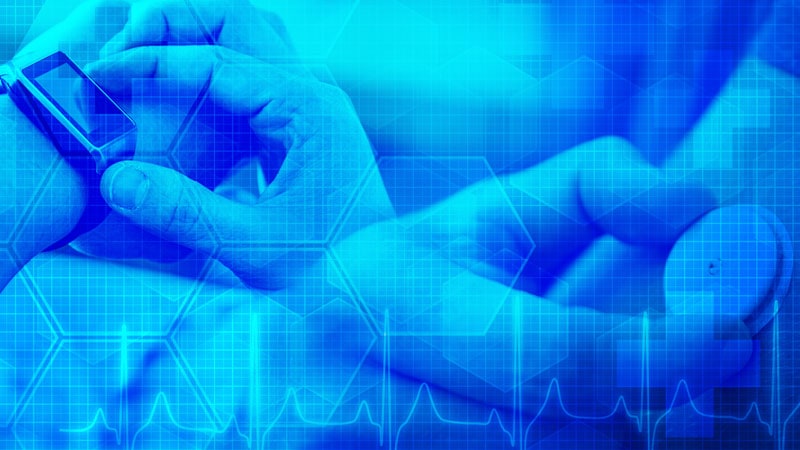This is the first in a two-part series on the future of wearable tech. Part two examines the incredible advances in power and electronics that will make future wearables work and can be found here.
Michael Snyder wears eight sensors on his body every day, including two smartwatches on each wrist.
Overkill? Some desperate innate need to get an accurate step count? (Gotta get your 10,000 in!) No. He is a geneticist studying how to track people’s health using wearables – the relatively new term for devices we wear on or close to our skin to measure anything from heart rate to how many stairs we climb each day.
In fact, it would be strange for him not to go hard with the electronic accessorizing. He’s director of the Stanford Center for Genomics and Personalized Medicine and one of the first to show how a smartwatch can detect infectious disease. Case in point: Snyder once used a smartwatch to detect his own Lyme disease before he had symptoms.
That’s just a glimpse of what wearables will soon be capable of for all of us.
We have a taste of this future today, of course. We live in an era where a watch counts your calorie burn, pants fix your downward dog yoga pose, and glasses display notifications right before your eyes.
But tomorrow’s wearables won’t just augment your workout or your cellphone – they will alert you to oncoming illness, manage chronic conditions, and help doctors tailor treatments to each patient’s unique needs.
And the best part is they’ll do all this outside the clinic – so you can spend that time working, socializing, or living your life.
Welcome to our wearable future.
Today’s ‘Stone Age’ Tech Hints at Tomorrow’s Medical Miracles
Science fiction has been promising us cool new stuff on our skin for decades – but what will our wearables actually look like and what will they be able to do? The future’s gaining pace thanks to advances in materials, sensors, and power sources aimed at next-gen wearables that accomplish two main objectives: Be less intrusive and more reliable.
In fact, this brave new wearable-world spans stages of development, and you can buy some of the gadgets right now.
Smartwatches measure heart rate and sleep patterns – emerging apps can use this data to spot a COVID-19 infection before you do. A snug shirt can measure your vital signs continuously in real time. And a skin patch on the back of your arm can measure your glucose levels 24 hours a day, no finger pricks needed – you can see in real time how your diet impacts your blood sugar, giving you a personalized road map for how to eat.
Still others are pushing further, striving to make wearables friendly to our day-to-day lives, making them smaller, more flexible, stretchable, and even washable.
Future wearables could be “invisible,” blending into your clothes or adapting to your body, says Veena Misra, PhD, director of the federally funded ASSIST Center, which brings together researchers at North Carolina State University and partner institutions to build next-gen health wearables.
Imagine a normal-looking shirt with invisible sensors knit into the fabric, or a device so small it can hide under your fingernail – or even inside you (this is not your grandmother’s pacemaker).
“When wearables can be very thin and skin-like, they’ll be more useful and impactful,” Misra says.
That said, success is not guaranteed. Developing this technology is, to use the technical term, really hard. Even if the science comes through, many hurdles will remain on the path to clinical and commercial use. While there’s plenty of excitement around wearables, we all know a new technology’s hype does not always predict market size. (Just ask any person still wearing Google Glass, if you can find one.) And global market intelligence firm IDC reported a dip in the wearables market in the first quarter of 2022.
Despite the challenges, researchers remain dedicated to making sure that no matter what devices hold the key to our future health care, we’ll wear them well.
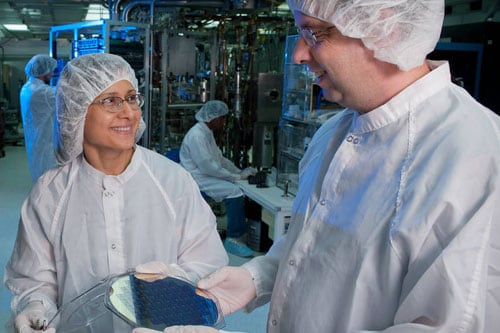
ASSIST Center director Veena Misra (center left) and her fellow researchers are developing self-powered devices that could someday help people monitor their health and predict disease.
Why Wearables?
“Big data” is positively gargantuan in health and medicine. As machine learning, artificial intelligence (AI), and data analytics evolve to harness the power of all this data, wearables are the ideal vehicles for collecting it.
These advancements are “symbiotic,” says Michael Daniele, PhD, an associate professor of electrical and computer engineering at North Carolina State University. “If we do the wearable right, it will deliver quality data that can then be put into the machine learning-AI-big data pipeline.” Likewise, that data is worthless without those tools to transform it into information, he says.
Unlike conventional methods – which you likely use only at doctor visits maybe once or twice a year – wearables can be donned anywhere, anytime, tracking data continuously and revealing health trends. That may help doctors “fill in the gaps” when making a diagnosis or prognosis, Daniele says. “It gives doctors another arrow in the quiver.”
It also empowers you, the average human, providing you with insight into your body in real time. Continuous monitoring provides a baseline – and your baseline is unique to you – revealing problems and alerting you to adverse events.
Hence Snyder flagging his Lyme disease before he felt a thing.
“You don’t drive a car around without a dashboard,” he says. “I would argue it’s just as crazy to go around without a health monitor.”
Research shows that smartwatches with EKG can diagnose atrial fibrillation (AFib) with surprising accuracy (and some major brands already have received FDA approval for AFib features), and they may one day prove useful for flagging heart attacks as well.
Snyder and his team have pioneered an app that pairs with a smartwatch to detect infection and disease.
“We can now tell if you have COVID in 80% of cases before symptoms occur,” he says. “The median is 3 days prior to symptom onset.”
He hopes to scale this technology within 5 years, making it available to every person. “3.8 billion people have a smartphone,” he says. “All you have to do is pair that with a smartwatch, and you have a health monitor for 3.8 billion people.”
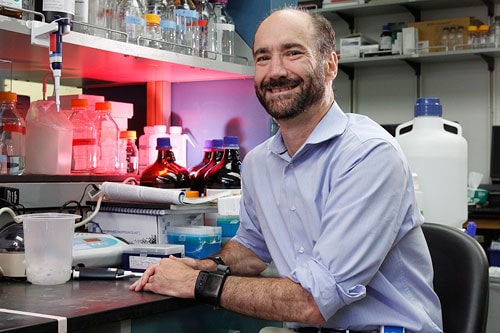
Geneticist Michael Snyder, PhD, of Stanford, was among the first to use commercial wearables – mostly smartwatches – for health tracking. He once detected his own Lyme disease using a smartwatch.
What Will Future Wearables Look Like?
Of course, before wearables can change the world, we must be willing to, you know, wear them.
That means devices that don’t scream “Hey, I have a health condition!” Convenience is also key – the less we have to manage and interact with them, the better. We feel those limits already today.
“I own an Apple watch, but the total number of hours a week I wear it is not more than 20,” says Alper Bozkurt, PhD, a professor of electrical and computer engineering at NC State. “One reason is I need to keep charging it, and I keep forgetting it on the charger. I arrive at my office and say, ‘Oh gosh, I forgot my watch.'”
Future wearables will be “wear and forget,” Bozkurt says. You just put it on and it fades into the background, no need to recharge or even really think about it.
What we’ll see:
Smart jewelry
We already have electronic watches and rings, and more smart jewelry (like earrings) will be coming. But for consumer adoption, watches and wristbands seem to have the most style appeal. And given their popularity – nearly 200 million shipped in 2021, according to tech research and consulting firm Gartner – the annual “new model” rollouts make even more marketing sense.
Still, as soft electronics advance, wrist-worn devices may become thinner, someday resembling a piece of tape wrapped around the wrist, Daniele says.
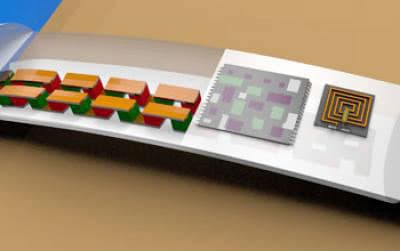
Researchers in the ASSIST Center are developing self-powered health monitoring systems. Some of these devices could be worn on the wrist, like a watch.
Clothing
Clothes tend to be useful for applying electronics and sensors across larger areas of the body, says Jesse Jur, PhD, director of ecosystem technology at Advanced Functional Fabrics of America. For example, “an Einthoven’s triangle that can clearly get an electrocardiogram signal,” he says, referring to a standard placement of leads across your body for an EKG.
Still, monitoring may be limited for a very basic human reason, says Jur: We change our clothes.
Many companies focus on athletic apparel. Athos carries smart garments that detect muscle activity during a workout. Sensoria Health offers upper garments that measure heart rate and socks that measure gait and foot strike.
Other applications may cross from consumer to clinical use. Montreal-based company Hexoskin sells shirts that monitor your heart rate and respiratory health. California-based Biotricity offers a chest strap sporting its FDA-approved heart monitoring system for cardiac patients, and the emerging company Nanowear carries an FDA-approved harness that captures 85-plus biomarkers in real time.
Today’s smart clothes tend to include removable parts (microcontroller, battery), but as the field advances, these may one day be integrated into the garment, Jur says. They’ll also be washable.
The article of clothing depends on what you want to measure. But compression is a must to retrieve info from inside the body. Possibilities include shirts, shorts, underwear, bras, headbands, skull caps, and arm sleeves, says Jur, who’s also head of nano-extended textiles research at NC State’s Wilson College of Textiles.
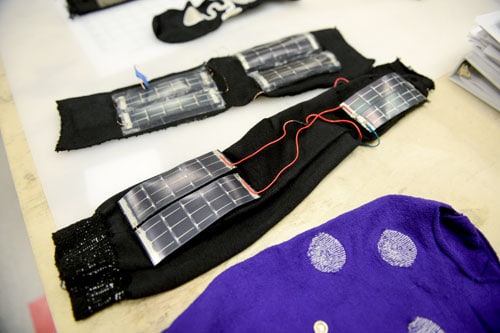
From Jesse Jur’s work at NC State’s Wilson College of Textiles: Flexible solar panels are attached to an arm sleeve to power sensors that monitor the effect of environmental conditions on the wearer.
Patches
Many experts are betting not on watches or clothes, but on a new class of wearable that adheres to the skin like a sticker, Band-Aid, or temporary tattoo. While patches are not yet widely accepted, they promise greater technical flexibility in how the sensor or skin-interface is built, Daniele says.
Arguably the greatest success to date is the continuous glucose monitor – like Abbott’s Freestyle Libre and the Dexcom G6 – which can be worn for 10 to 14 days, testing glucose every few minutes and transmitting the info wirelessly to your cellphone. Typically worn on the belly or back of the arm, these work through a tiny sensor inserted under the skin to measure the glucose level in interstitial fluid – fluid in the space between cells.
Another fluid that may prove useful: sweat. Researchers are already able to measure glucose and lactic acid levels in sweat, and efforts are underway to discover what else in sweat could be useful.
What Will Future Wearables Do?
The potential for new worldwide health applications is enormous. In some cases, wearables may make tracking your health easier. Switch out a stethoscope for a chest patch, say, or a bulky Holter monitor for a comfy shirt. Need some lab work? Skip the needle and slap on a sweat or interstitial fluid sensor instead.
Other areas being researched:
Gentle, skin-like sensors. John Rogers, PhD, a professor of materials science and engineering, biomedical engineering, and neurological surgery at Northwestern University, has already developed a “very soft, thin, flexible skin-like” wireless sensor that is very gentle. It’s designed so anyone can benefit, but he suggests premature babies in intensive care “could benefit most.”
These fragile patients must have vital signs monitored continuously, involving a “rat’s nest” of wires and tape, he explains. But he and his team (through their startup Sibel Health) have developed wireless monitoring sensors that spare the baby’s delicate flesh and help provide healthful skin-to-skin contact with the mother.
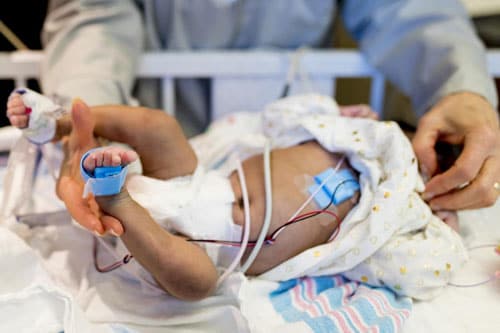
John Rogers and his team at Northwestern have developed an affordable, wireless monitoring system for newborns. Here, a neonate at Prentice Women’s Hospital in Chicago wears the wireless sensors (in blue) alongside traditional, wired sensors so the researchers can test and evaluate the sensors side-by-side.
Because these sensors are reusable and can work with smartphones, they may be ideal in developing countries that can’t afford a lot of expensive monitoring equipment, Rogers says. Thousands have already been deployed to Zambia, Ghana, Kenya, India, Pakistan, and Mexico.
“The death rates of newborns in low- and middle-income countries remain extremely high,” says William Macharia, MD, a pediatrician at Aga Khan University, in Nairobi, Kenya, who has tested the device on about 250 newborn patients in intensive care. “Most deaths happen within the first 2 weeks.”
With this device, babies could be monitored much sooner, revealing problems earlier and hopefully saving lives, he says.
The platform – which received FDA clearance for noncritical care in adult patients – could have applications across medical departments. Rogers is also exploring uses in maternal health, stroke survivors, and Parkinson’s and Alzheimer’s patients. One version can screen for sleep apnea, effectively bringing the sleep lab into your home.
Mental health monitoring and diagnosis. Certain mental health conditions could become more easily treated via wearables that, for example, measure stress hormones. “There’s an increased interest in trying to measure cortisol levels in humans,” says Zhenan Bao, PhD, a professor of chemical engineering at Stanford University.
Doctors already test cortisol levels through blood, saliva, or urine. But a wearable could – through interstitial fluid or sweat – be used to track cortisol continuously, establishing a baseline and tracking whether a patient’s stress levels are getting better or worse, she says.
Not only that, this information could be combined with other measures of body functions, like heart rate and skin conductance, to reach a more precise diagnosis and treatment, Bao says.
Drug adherence and dosing. Sweat may prove key to drug monitoring, says Jason Heikenfeld, PhD, a professor of electrical engineering at the University of Cincinnati. Not only will we be able to know if a person has taken a drug, doctors can monitor how quickly each person metabolizes it. This will allow doctors to prescribe custom dosages, reducing side effects and making drugs more effective.
“It’s going to be the Stone Age,” Heikenfeld says of current times. “We’re going to be like, you went to a store and your 85-year-old grandmother who weighs 95 pounds, and you who are 32 and overweight, got the same bottle of X that says ‘take this many every four hours up to this dose.’ It doesn’t make any sense.”
And so much more. Misra and her team at the ASSIST Center are developing sensors for measuring air quality, possibly letting us predict respiratory health. Other devices could measure human smell – volatiles in the breath are associated with cancer – revealing whether a cancer patient is in remission, for example, Misra says. Tracking behavior in older adults could help detect changes in thinking skills or memory.
“Wearables will become more and more a predictor of health,” Misra says. If we can predict conditions or catch disease early, we can intervene sooner and have better health outcomes.
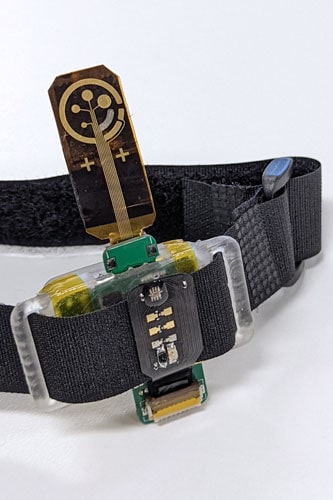
Optical and electrical sensors on this platform, developed at the ASSIST Center, can simultaneously measure heart rate, oxygenation, lactate, cortisol, and pH level. Correlating multiple biomarkers can provide insight into cardiovascular health, stress, metabolic health, and a lot more.
As these devices become more accepted, they’ll cross over from health care into consumer wellness, improving not just medical outcomes but also lifestyle changes on a wide scale, Daniele says.
“And then there’s the blue sky,” he says. “If everyone’s wearing a device that measures something, can we start doing things like population health analysis?” Or could we more strategically stop the spread of infectious disease?
Still, even while labs are bursting with demonstrations, the real-life transition raises questions: Will people wear the wearables? Will these devices provide quality data? How will that data hold up to our current gold standards across medicine?
Misra is optimistic. She predicts serious evolution in wearables in clinical and commercial settings within 5 years.
After all, many of us are already used to having data collection devices on or around us. Which means the future of health and medical tech, in so many ways, is already here and on your wrist … just waiting for an upgrade.
Sources
Michael Snyder, PhD, director, Stanford Center for Genomics and Personalized Medicine.
PLOS Biology: “Digital Health: Tracking Physiomes and Activity Using Wearable Biosensors Reveals Useful Health-Related Information.”
FastCompany: “These Vibrating Yoga Pants Will Correct Your Downward Dog.”
Business Insider India: “Xiaomi’s first smart glasses can take calls, capture photos, translate text and more.”
Hexoskin.
The New York Times: “Can Technology Help Us Eat Better?”
Veena Misra, PhD, director, Center for Advanced Self-Powered Systems of Integrated Sensors and Technologies (ASSIST), North Carolina State University.
International Data Corporation: “Wearables Market Sees First Decline at Beginning of 2022 as Demand Normalizes, According to IDC.”
Michael Daniele, PhD, associate professor of electrical and computer engineering, North Carolina State University.
JACC: Clinical Electrophysiology: “The WATCH AF Trial: SmartWATCHes for Detection of Atrial Fibrillation.”
Harvard Medical School: “Can a smart watch diagnose a heart attack?”
Alper Bozkurt, PhD, professor of electrical and computer engineering, North Carolina State University.
Stanford Healthcare Innovation Lab: “Infectious Disease and COVID-19 Wearables Study.”
Statista: “The Global Wearables Market Is All About the Wrist.”
Jesse Jur, PhD, director, ecosystem technology, Advanced Functional Fabrics of America; head of nano-extended textiles research, North Carolina State University Wilson College of Textiles.
Athos: “Building Better Athletes.”
Sensoria: “Smart Sock v2.0 & Sensoria Core.”
Biotricity: “Bioheart.”
Nanowear: “Smarter Care. Anywhere.”
National Institute of Diabetes and Digestive and Kidney Diseases: “Continuous Glucose Monitoring.”
Abbott.
John Rogers, PhD, professor of materials science and engineering, biomedical engineering, and neurological surgery, Northwestern University.
Sibel Health: “Better Health Data for All,” “Sibel Health Announces FDA Clearance for ANNE One – A Flexible, Wireless Vital Signs Monitoring Platform.”
William Macharia, MD, pediatrician, Aga Khan University, Nairobi, Kenya.
Zhenan Bao, PhD, professor of chemical engineering, Stanford University.
Jason Heikenfeld, PhD, professor of electrical engineering, University of Cincinnati.
Gartner: “Forecast Analysis: Wearable Electronic Devices, Worldwide.”
Source: Read Full Article






